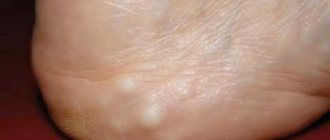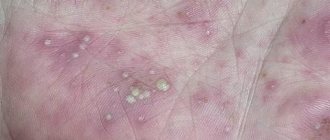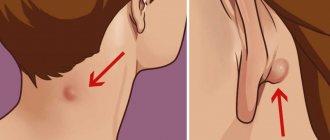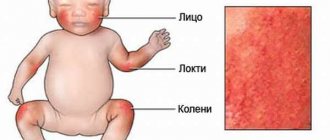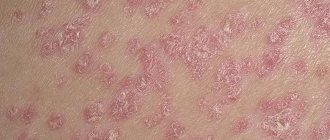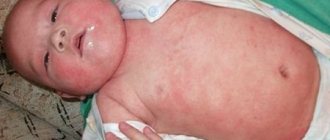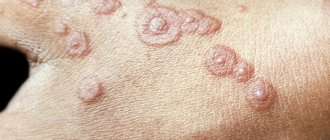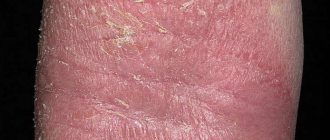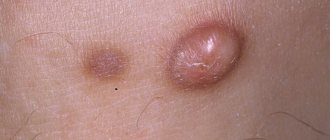More about eczema
Eczema is an inflammatory skin disease that causes itchy, moist rashes. It occurs under the influence of various irritating factors against the background of a predisposition formed as a result of changes in the immune system. As a result, the body begins to react abnormally to the action of irritants, which is clinically manifested by skin rashes.
Classification and types of eczema:
- true;
- professional;
- microbial;
- fungal;
- varicose;
- seborrheic.
At the onset of the disease, local redness and swelling are noted on the skin. Then bubbles with serous contents appear. They burst, the liquid flows out and forms a wet surface with cracks. After a while, the affected areas dry out and form crusts, after peeling off which healthy skin remains. But in parallel, new rashes may appear, prolonging the course of eczema. And if it is not treated, the disease will become chronic with frequent relapses in the form of new episodes of the disease. At the same time, the skin gradually thickens, peels off, and even during periods of remission does not look the same as before.
Causes
Most often, the disease occurs against the background of a hereditary predisposition to it, but often the disease also appears in people who have never had atopic diseases in their family. In recent years, the number of cases of atopic eczema has increased, this is due to poor ecology, poor nutrition of adults, early complementary feeding of infants, and feeding with artificial formulas.
Eczema is usually associated with an autoimmune reaction. That is, any allergen affects the body and forces the immune system to destroy its own skin cells, mistaking them for a foreign agent. This causes inflammation and characteristic rashes.
The disease occurs when negative factors influence the body. If a person never comes into contact with an allergen, then even if there is a genetic predisposition, he may never develop dermatitis. And a person without a predisposition, but who is constantly exposed to negative factors, has every chance of getting sick.
Causes of rashes:
- Allergies to food, pollen, chemicals, medications, constant contact with allergens;
- Frequent stressful situations, overwork;
- Weakened immunity, frequent colds;
- Problems with the gastrointestinal tract, liver and kidneys.
Most often, exacerbation of the disease is associated with contact with allergens. Rashes appear precisely when a person eats prohibited foods or comes into contact with an allergen through touch.
More about dermatitis
Dermatitis is also an inflammatory skin disease. Most often, this is an acute reaction to the influence of some irritating factor, external (exogenous) or internal (endogenous).
Exogenous stimuli include:
- various chemicals (cosmetics, household chemicals, etc.);
- Sun;
- freezing;
- contact with clothing, shoes, jewelry;
- plant pollen;
- animal hair;
- medications;
- vaccines during vaccinations;
- insect bites;
- food, etc.
- various diseases;
- stress;
- overwork;
- infectious and fungal diseases;
- foci of chronic infections, etc.
Dermatitis is usually an acute pathology and resolves with treatment. It rarely becomes chronic, with the exception of atopic dermatitis.
- allergic;
- contact;
- atopic;
- neurodermatitis;
- infectious;
- fungal;
- seborrheic.
Rashes with this disease can be of a different nature - wet or dry, with blisters or papules, with cracks or crusts, etc. They are almost always accompanied by itching.
Treatment
Therapy for eczematous dermatitis is based on five pillars:
- Stopping skin exposure to an allergenic substance.
- Treatment of underlying diseases and conditions that provoked the development of the disease.
- Lifestyle changes: exclusion of allergenic foods (chocolate, nuts, seafood, citrus fruits), sleep at least 8 hours a day, optimally at night, maximum avoidance of stress.
- Systemic therapy with antihistamines and desensitizing drugs.
- Local treatment of affected areas.
The dermatologist should tell you how to treat eczematous dermatitis topically after an examination, since there are a large number of different hormonal and non-hormonal agents.
In the initial stages, when redness has just appeared, you can use zinc ointment, Desitin or Skin-cap.
At the stage of the appearance of a weeping surface, the use of talkers and wet or wet-dry dressings is prescribed. If severe itching is noted, you can use hormonal creams or lotions: based on betamethasone dipropionate or valerate, hydrocortisone butyrate, mometasone furoate.
During the period when dry crusts appear, as well as during peeling and dry skin, products that promote wound healing are needed: Levomekol, Bepanten (Dexpanthenol), Actovegin or Solcoseryl.
In case of a chronic process, hormonal ointments are prescribed. They should be chosen by a doctor based on the severity of inflammation.
For any form of eczematous dermatitis, it is necessary to use emollients - products that will prevent the evaporation of fluid from the surface of the skin.
We offer you to read an article about contact dermatitis, its symptoms, causes and types. About this at the link.
Traditional treatment
The following folk remedies are used:
- Lotions with potato juice. To do this, you need to grate the raw, peeled root vegetable, put the pulp in gauze and squeeze it over a clean bowl. The resulting juice is soaked into another gauze, which is applied to the inflamed areas for 10-15 minutes.
- To reduce itching, apply lubrication with a soda solution. 1 tbsp. l. dissolve soda in 200 ml of warm water. A piece of cotton wool is moistened with the solution and used to wash areas of dermatitis.
- For this remedy you will need 200 g of aloe leaves, 150 g of castor oil, 50 ml of dry red wine. Aloe leaves are cleaned, finely chopped and placed in a cool place for 14 days. Then add the remaining 2 ingredients to them and mix. Soak gauze with the mixture and apply to areas of dermatitis for 10-15 minutes.
We recommend a thematic video about allergic dermatitis:
If you are prone to developing allergies, it is important to use hypoallergenic household chemicals and cosmetics, watch your diet and spend more time in the fresh air. Remember that eczematous dermatitis, although an unpleasant disease, is curable. Proper nutrition and further prevention will help you cope with it. Have you ever experienced allergies? What means do you use to cope with its manifestations?
The main differences between eczema and dermatitis
As mentioned above, eczema is characterized by a chronic course, while dermatitis is predominantly acute. This is the main difference between eczema and dermatitis.
Another important difference is in the mechanism of disease development. Dermatitis is caused directly by irritating factors. For eczema to occur, changes in the immune system are necessary, which provoke perverse skin reactivity.
The rashes associated with these two diseases can be very similar. But eczema is distinguished by the presence of false polymorphism - the simultaneous presence of various elements of the rash in the lesions. With dermatitis, there is a gradual evolution of rashes and polymorphism phenomena are almost never observed.
Atopic dermatitis and eczema
Atopic dermatitis and eczema have many similarities in their manifestations and development mechanisms. The main differences lie in the age of the patients - adults are more susceptible to eczema, children are more susceptible to atopic dermatitis. The rashes also differ - in the first case the process is wet, in the second it is dry without bubbles. Often, atopic dermatitis in childhood leads to the development of true eczema in adults.
Allergic dermatitis and eczema
In most cases, allergic dermatitis and eczema are very different. Despite the fact that the same allergens can cause both of these diseases. In the case of dermatitis, there is a clear connection between its occurrence and contact with plant pollen, animal hair, consumption of certain foods, etc. The rash is accompanied by severe itching, usually dry, without a weeping process. In parallel, lacrimation, sneezing and rhinitis are observed.
With eczema, data on contact with allergens cannot always be identified. The rashes are moist, with blisters and cracks, and over time turn into a dry rash with crusts. There are no associated symptoms from the eyes and nose.
Contact dermatitis and eczema
Contact dermatitis is difficult to confuse with eczema.
With this disease, the rashes are localized strictly at the point of contact with the irritating factor and appear almost immediately after contact with it. The rash is swollen, hyperemic spots, without blisters or weeping, with clear boundaries. With eczema, blisters and weeping are observed, turning into dry crusts. The rash zone can be localized anywhere, regardless of contact with irritating substances and allergens.
You can clearly see the difference in skin manifestations in these two pathologies in the photo.
When exposure to the allergen is eliminated in contact dermatitis, recovery occurs spontaneously. Eczema requires long-term treatment. This is another difference between these two diseases.
Neurodermatitis and eczema
Neurodermatitis also develops with changes in the body's reactivity system. The reason for this is allergenic and neurogenic factors. This disease is often accompanied by disturbances in the balance of the sympathetic and parasympathetic systems, which is manifested by vegetative-vascular dystonia.
Rashes with neurodermatitis are similar to those with eczema and are also accompanied by severe itching, which intensifies at night (this is not the case with eczema). But the rash may contain elements that are unusual for eczema - nodules, papules, congestive erythema, etc. In parallel, irritability, anxiety, sleep disturbances, and weight loss are observed. Therefore, there are neurogenic causes of the disease.
Seborrheic dermatitis and seborrheic eczema
The clinical manifestations, causes and treatment of seborrheic dermatitis and eczema are very similar. Most often, eczematous rashes with this type of disease appear after the manifestation of dermatitis as a complication. The course of the disease is significantly influenced by the nature of nutrition, the state of the hormonal and nervous systems.
The rash can be either dry or wet (oily). The color of the crusts and the severity of peeling depend on this.
The only difference between these two pathologies is that dermatitis is provoked by a violation of the secretion of the sebaceous glands. With the development of eczema, there is also an inflammatory reaction on the part of the skin due to its impaired reactivity. But clinically there are no differences, and the treatment of these two diseases is also similar.
Infectious dermatitis and microbial eczema
Infectious dermatitis, as a rule, is one of the symptoms of various infectious diseases - measles, rubella, scarlet fever, chickenpox, etc. The nature of the rash depends on the type of infection that caused the pathology.
The rash can manifest itself as papules, vesicles, spots, hemorrhages, etc. Itching is not always accompanied. Deep skin lesions develop when infected with streptococcus and staphylococcus. In this case, painful pustules of various sizes are found on the skin (up to boils or carbuncles). The course is acute and does not become chronic.
How does atopic dermatitis differ from contact eczema?
| Atopic dermatitis | Contact eczema | |
| reasons for occurrence | exposure to external stimuli | the disease is preceded by prolonged exposure to allergens on the dermis |
| allergens | begins to appear in the presence of at least one allergen | microbial contamination of the skin, viruses, mechanical friction, scratching, internal somatic diseases (sinusitis, tonsillitis, gastritis, hepatitis, etc.) |
| localization | appears in closed areas of the skin, in skin folds | affects any area of the skin |
| rashes | have a uniform, continuous character | various rashes. The location of lesions and healthy areas have blurred boundaries |
| bubbles | not observed | the blisters tend to ooze, and in the presence of infection, erosion and suppuration are possible |
| outcome of the disease | has a sharp shape. Eliminating allergens leads to recovery. Exacerbations of the disease may occur. | has a chronic course |
What is eczema
Eczema
(from the Greek ekzein - to boil) is an acute or chronic non-contagious inflammatory skin disease of an allergic nature, characterized by a variety of rashes, burning sensation, itching and a tendency to relapse.
Eczema or dermatitis
is a collective term used to describe a group of different symptoms, it can be acute or chronic and occurs as a result of a variety of causes. The medical dictionary lists 21 types of eczema (dermatitis). Clinical signs are similar for all types of eczema and vary in the duration of the rash.
Stages of eczema
— Acute eczema
manifested by: redness, swelling, rashes in the form of papules, vesicles (vesicles), exudation and soaking of lesions, usually with fuzzy edges, severe itching, peeling.
— Subacute eczema
manifests itself: erythema, rashes in the form of papules, plaques, peeling, itching.
— Chronic eczema
manifested by: erythema, peeling, lichenification, xerosis, hyperkeratosis, itching, hypo- and hyperpigmentation.
Diagnostics
To make a correct diagnosis, the specialist carries out the following activities:
- asking the patient about all the symptoms of the disease;
- taking an anamnesis;
- examination of the skin.
In some cases, the patient is prescribed:
- histological examination (taking particles of damaged skin);
- laboratory blood and urine tests;
- hormonal study.
Only after confirmation of the diagnosis is the treatment method determined.
Types of eczema
Idiopathic or true eczema
It occurs at any age and is characterized by an acute onset with a chronic course and periodic relapses; it is impossible to determine the cause.
Dry eczema or eczematous dermatitis
It is caused by cracks and severe dryness of the skin. Dry eczema is characterized by a slow, chronic course. Exacerbations occur in winter due to low air humidity. Provoking factors include diseases of the gastrointestinal tract, liver, stress and lack of vitamins.
Weeping or wet eczema
Weeping eczema sometimes transforms from the dry form. It manifests itself as extensive inflammation of the skin of a polyetiological nature, occurring as an acute form with areas of weeping with a macerated and exfoliating stratum corneum. May be the result of idiopathic or true eczema.
Atopic eczema or atopic dermatitis
Atopic dermatitis is a chronic inflammatory recurrent skin disease accompanied by itching and exudative and/or lichenoid rashes. Most often it occurs in childhood and has characteristic age-related localization features. This eczema is hypersensitive to allergens and nonspecific irritants. Atopic dermatitis is hereditary and is often accompanied by other allergic diseases (bronchial asthma, hay fever). It has a clear seasonal dependence: in winter - exacerbations or relapses, in summer - partial or complete remissions.
Numular eczema
Happens quite often. This eczema has coin-shaped eczematous lesions. The extremities are most often affected, although the back and buttocks may be affected. Numular eczema occurs more often in young people who abuse alcohol, as well as in older men. In addition, it can occur in children suffering from atopic dermatitis, which is difficult to treat.
Allergic dermatitis or contact eczema
Allergic dermatitis is a disease that develops as a response of the patient’s body to exposure to a facultative irritant (i.e., a substance to which normal healthy people do not develop allergic reactions) through direct contact with the skin for even a fairly short time. A localized reaction is manifested by redness, itching, and burning in places where the skin came into contact with the allergen. After treatment (removal of the allergen), the symptoms completely disappear.
Seborrheic eczema or seborrheic dermatitis
It differs from seborrhea in that the initial cause is not a malfunction of the sebaceous glands of the skin, but an inflammatory disease of the skin itself. Seborrheic eczema is characterized by peeling skin and itching. It occurs due to hormonal imbalances, changes in diet and nervous stress.
Asteatotic eczema
It is observed in older people, especially with dry skin. Factors contributing to the development of the disease: low humidity, frequent washing, use of diuretics. More often it develops on the lower extremities in the form of a corrugated skin pattern or small cracks on an erythematous background.
Static (gravity) eczema or varicose eczema
Varicose eczema is most often localized on the lower extremities, accompanied by venous insufficiency (swelling, redness or bluish discoloration of the skin, lack of hair, induration, hemosiderin deposition and ulceration) and the development of hypersensitivity to external antibiotics and antiseptics.
Lichen simplex or neurodermatitis
Neurodermatitis manifests itself as plaques of lichenified eczema that appear as a result of rubbing or scratching as a habit or in response to stress. Often localized on the back of the neck, lower extremities and in the anogenital area.
Dyshidrotic eczema or dyshidrosis
It is localized on the palms, on the inner surface of the fingers and toes - recurrent blisters and blisters appear there, accompanied by severe itching. This form of eczema occurs in atopic eczema, simple contact and allergic dermatitis, but often this form can be idiopathic.
Microbial eczema
Formed in places of chronic foci of pyoderma (around infected wounds, trophic ulcers, fistulas, abrasions, scratches). It is characterized by the formation of blisters with purulent contents and rough, weeping skin.
Mycotic eczema
An allergy to fungal infections affecting the nails and skin develops. Localized on the feet and hands.
Similarities and differences between diseases
With both dermatitis and eczema, inflammation of the skin occurs. The skin is affected by various types of rashes, inflamed, and itchy. There are many factors underlying the development of dermatitis; eczema often occurs as a consequence of dermatitis, this is their difference.
When the acute inflammatory manifestations of dermatitis subside, crusts, blisters or scales remain on the skin, this is eczema, a consequence of dermatitis.
Having found out the nature of the appearance of dermatitis, it can be cured, but if eczema has developed, then its relapses can be observed throughout the patient’s life. These frequent relapses distinguish eczema from dermatitis.
Causes of eczema
Eczema usually appears in childhood, followed by a period of remission, followed by a relapse in adulthood. As a rule, people with reduced immune function, suffering from allergies, respiratory infections and allergic rhinitis get sick.
The cause of the disease can be anything, it is different for everyone, and usually, until the cause is found, the process of deletion continues. For some, the reason may be clothing, for others, temperature changes, dust and/or dandruff, detergents and even fruit juice.
Clinical picture
The leading symptom of atopic eczema is painful itching (constant or periodic). In addition, the clinical picture of the disease includes:
- multiple rashes on the patient’s body, the nature of which depends on the phase of the pathological process;
- redness and swelling of the skin in the affected areas;
- sleep disorders;
- dryness and cracking of the skin.
The development of atopic eczema is divided into three phases: infant (from birth to 18 months), childhood (1.5-13 years) and adult. They differ from each other in the nature and location of the rashes. Thus, the development of the disease in adults is characterized by the appearance of erythematous foci of pale pink color with a papular rash and a distinct skin pattern. The rashes are localized on the face, neck and flexor surfaces of the limbs. In children under 13 years of age, atopic dermatitis manifests itself as bright pink erythematous spots, a vesicular rash, and areas of weeping. The largest foci of the disease are located on the skin of the limbs, buttocks and face.
Often, atopic eczematous dermatitis is complicated by a fungal, pyococcal or viral infection. Advanced forms of this pathology can lead to the development of hay fever, bronchial asthma and other allergic diseases.
A sensitive problem
One of the main problems is itching. Irritation from itching is similar to pain signals - they both affect the same nerve fibers. Scratching relieves itching because it blocks signals transmitted along the nerve to the central nervous system. In eczema, this same scratching leads to thickening of the surface of the skin, as well as damage to the skin and the release of more inflammatory mediators, causing even more itching. And so everything repeats itself - a vicious circle. Some of these mediators are serotonin, prostaglandin, peptides and proteinase - chemicals that are constantly present in the skin.
Treatment methods
The key goals of treatment of atopic dermatitis (eczema) are the elimination of allergic factors, desensitization and detoxification of the body, blocking the inflammatory process, eliminating itching, restoring the structure and functions of the skin, correcting concomitant pathologies, combating complications of the disease and preventing its relapses. The treatment regimen may include:
- avoiding contact with allergens;
- creating a favorable psycho-emotional environment;
- taking antihistamines;
- the use of drugs that have a calming effect on the central and autonomic nervous system;
- use of medications that have a hypnotic effect;
- ultraviolet irradiation of problem areas 3-4 times a week;
- taking detoxification medications;
- extracorporeal blood purification (plasmapheresis, hemosorption);
- use of dietary supplements containing fatty acids;
- prescription of anti-inflammatory drugs;
- use of corticosteroids;
- sharp limitation of table salt consumption;
- intravenous infusions of saline or dextran;
- drying, anti-inflammatory and disinfecting lotions;
- taking immunomodulators;
- the use of ointments and creams containing anti-inflammatory and antipruritic components;
- specific immunotherapy;
- prescribing antiviral, antibacterial and antifungal drugs when a secondary infection occurs.
Patients are recommended to follow a therapeutic diet that includes the exclusion of food allergens from the diet: eggs, cow's milk, fried vegetables, fish and meat, rich broths, citrus fruits, honey, chocolate, strawberries, black currants, nuts, melon, mushrooms, spices, smoked foods and caviar. Along with this, patients are advised to avoid eating products containing preservatives and dyes.
Treatment of eczema
Treatment of eczema should be based on the golden rule of dermatology - “treat wet with wet, and treat dry with dry.” Weeping eczema should be treated with lotions - various solutions, decoctions, tinctures, and they must be cooled in order to overcome local inflammation and reduce the activity of inflammatory processes. Dry eczema should be treated with ointments and creams.
Drug treatment of eczema
1. Over the years, many methods have been tried with varying degrees of success. Until recently, resin wraps were used. The other main method was phototherapy - PUVA therapy, which used ultraviolet light and a medicine called Psoralin. The same treatment was prescribed for psoriasis.
2. Topical and systemic corticosteroids have been used for many years despite side effects.
3. Topical antihistamines for itching and to reduce redness.
4. Topical immunomodulators are a new class of drugs that have been used over the past five years with great success. They change the speed of the immune reaction, which in more than 80% of cases helped get rid of all the symptoms of the disease.
5. There is a new subset of biologics that have proven themselves in clinical trials that are more targeted against T cells.
Aesthetic treatment
Stress and/or a lack of essential fatty acids (EFAs) have long been considered the main cause of eczema. Stress-reducing treatments combined with ingredients rich in essential fatty acids have been shown to work well in treating many forms of eczema. A lack of gamma-linolenic acid is also associated with this disease. You need to think carefully about fats (at least EFAs) when choosing anti-anxiety, sleep-reducing, or stress-reducing medications. Ingredients such as borage oil, evening primrose oil, rosehip seed oil, ceramides, lecithin, linoleic and linolenic acids are a good source of essential fatty acids.
Essential fatty acids help the skin in every possible way, keeping it soft and elastic. The hydrolipid balance and barrier functions of the skin also depend on EFAs. A constant supply of essential amino acids is essential to keep your skin in optimal condition. This is especially important when the normal functioning of the skin is disrupted, for example, by eczema. In addition, you need to eat foods rich in vitamin E and vitamin A.
A diet for eczema is absolutely necessary. You can tell your patients, casually, that eating plant-based polyunsaturated fats from nuts and seeds and different types of fish will be very beneficial. The idea needs to be presented this way, because you cannot put people on a diet if you do not have special education.
The use of scrubs and chemical peels for eczema is contraindicated, as well as classical massage; only lymphatic drainage massage is possible.
Hardware procedures are not contraindicated, although it is recommended to use the vaporizer with caution. Keep him at a greater distance from the client than usual, and not for as long. Remember that temperature changes can cause aggravation. Avoid using hydrotherapy and the like to treat patients with eczema or other dermatosis; the water should be warm or even cool - not hot.
Moisturizing skin for eczema
Be careful with transepidermal water loss (TEWL) due to the weakening of the epidermis, dehydration of the skin can occur. Therefore, blot the skin, do not wipe it dry. Apply moisturizer immediately (within three minutes). For skin with this condition, it is best to use oil-based products; do not use water-based lotions - they do not help much.
As you know, water does not moisturize the skin as well as water vapor, so wet wraps are more effective than immersion treatments. This is because when wrapping the relative humidity is maintained at almost 100%, therefore no water evaporates from the skin. This, in turn, keeps the skin hydrated. Once you've done this on a cleansed body, all that's left to do is apply an oil-based moisturizer and a broad-spectrum sunscreen. Especially if it contains zinc oxide, which has proven itself in the treatment of wet eczema. Don't let your skin dry out during treatment - use a toner between treatment steps to help rebalance your pH balance.
The normal environment of the skin is acidic (normal skin pH is from 5 to 6). Due to the constant loss of hydration associated with eczema, the skin environment can become alkaline. For this reason, it is not recommended to use soap. Water has an alkaline environment (pH = 8-10), so many find salvation in adding apple cider vinegar to it, which makes the environment neutral or slightly acidic (any vinegar will do, but it is recommended to use apple cider vinegar because it does not smell as strong as the others ). Products for cleansing and toning the skin should contain fruit acids; it is good if the cleanser does not need to be washed off with water, it is milk or cream.
Treatment options
Eczematous dermatitis is not a common allergic disease that can only be cured by eliminating the influence of the irritant. In this case, it is necessary to carry out complex treatment aimed at reducing the body’s sensitivity to the allergen.
It consists of using external agents at the initial stage: drying and disinfecting creams, ointments, aerosols, gels and mash of pharmacy and home preparation, wet dressings.
External treatment helps to alleviate the patient’s condition, reduce skin itching and improve the condition of the epidermis. If the use of external agents does not bring the expected effect, systemic drugs are added to the treatment process:
- new generation antihistamines that do not cause drowsiness (Cetirizine, Claritin, Zyrtec) reduce skin itching and eliminate swelling;
- wound healing agents (Panthenol, Bisabolol, Solcoseryl) nourish the skin, accelerate the healing process and regeneration of damaged areas;
- sedatives (valerian, motherwort, Sedavit, Novopassit, Persen) help eliminate irritability, anxiety, and promote sleep.
- antibacterial ointments (Levomekol, Syntomycin, Gentamicin, Tetracycline) destroy pathogenic microbes, help cleanse wounds and help them heal;
- vitamin complexes are used to improve the general condition of a person;
- emollients help eliminate drying of the epidermis and avoid the formation of cracks and wounds, protect the skin from the influence of harmful factors;
- non-hormonal ointments (Skin-cap, Losterin, Exoderil, Bepanten) have an antimicrobial effect, reduce the inflammatory process, and activate the restoration of the skin;
- corticosteroid hormonal ointments (Flumetasone, Celestoderm, Dexamethasone, Prednisolone) have a pronounced anti-inflammatory and antiallergic effect, have an antioxidant and immunosuppressive effect;
- immunosuppressants (Cyclophosphamide, Myelosan, Cyclosporine) suppress the immune system and help the body cope with the external manifestations of dermatitis.
Physiotherapeutic procedures are used as an addition to the treatment of eczematous dermatitis:
- laser therapy;
- cryotherapy (cold treatment);
- mud therapy;
- ultraviolet irradiation;
- phototherapy;
- magnetic therapy.
Treatment of eczematous dermatitis should be carried out only in accordance with doctor's prescriptions; self-medication is unacceptable, as it can lead to tissue necrosis.
Herbs and essential oils for eczema
Anti-inflammatory:
Calendula, chickweed, echinacea, nettle, red clover, essential oil of orange, cypress, jasmine, lavender are some of the possible ones.
Antibacterial:
Black walnut, calendula, chaparrel, hydrastis canadensis, tea tree oil, cloves, lemon balm, thyme.
Sedatives:
Flower and herbal extracts play an important role, especially during stress. Motherwort, valerian, bergamot, peony, radiola rosea, mint, lemon balm, St. John's wort, geranium, passionflower, hawthorn are very effective in combating stress. In addition, you can perform aromatherapy with essential oils.
Estheticians can do a lot for patients with eczema. I hope this information will be a kind of instruction for you on how to care for skin with this disease. Remember that ultimately this is a medical condition and sometimes advice to see a dermatologist is the best you can do for some people.
Eczema: photo
eczema on the wrist eczema on the hands eczema on the face around the eyes eczema on the hands eczema behind the ear
eczema on legs
eczema on fingers
weeping eczema dry eczema
Microbial eczema
Latest blog posts on our website
Latest forum topics on our website
Other articles in this section
| Skin pigmentation: causes, consequences and methods of treatment In order to be able to offer a method of treating pigmentation with a long-term effect, a modern specialist must fully understand the condition in which the skin is. He must have in-depth knowledge of the cells and body systems involved in the problem in order to confidently choose a corrective program. |
| Stye on the eye: causes, symptoms and treatment Stye on the eye is an unpleasant thing. Let's start with the fact that it greatly spoils the appearance, as it causes swelling and redness. It is simply impossible to hide such a defect with makeup. In addition, a small purulent ball on the eyelid causes severe pain and discomfort. |
| Does the epidermis renew itself every 30 days? If the epidermis is renewed every 30 days, then why don’t you have beautiful and perfect skin every month? The answer to this question is in this article. |
| Treatment of psoriasis of the scalp In modern dermatology, psoriasis is one of the most pressing social and medical problems, due to its significant percentage from 14.6% to 24% of the total structure of all skin diseases. Moreover, psoriasis is most often found in the scalp. According to various authors, this form of the disease among all varieties of this disease ranges from 50 to 80%. |
| Peeling skin on the face: reasons, what to do Every person at least once in their life faces such a problem, peeling skin on the face in winter or at other times of the year. This article will tell you what the causes of peeling are and how to eliminate it. |
| Photosensitivity of the skin An important role in determining the effectiveness of a particular treatment is played by establishing the cause of skin disease associated with pigmentation - this is the first task that a doctor must solve to draw up an effective treatment plan. If the disease is caused by taking medications for external or internal use, such as corticosteroids or birth control pills, then positive results cannot be guaranteed until the use of the medication is stopped. |
| Water as a remedy or why do we need these six glasses of water a day? The answer to this question haunts many, let's try to answer it from a scientific point of view. Water is the most important nutrient for skin health and overall well-being. The human body is composed of 45-55% (by weight) water and this water must be constantly replenished to prevent stagnation and the accumulation of toxins in our cells and tissues. |
| Laser removal of papillomas Laser removal of papillomas is an absolutely safe and effective way to get rid of skin lesions located on any area of the skin, including the face. |
| Dehydration of the epidermis Dehydration (dehydration) is the cause of many skin diseases, but is not a disease in itself. As a result, diagnosing dehydration is a particular challenge. |
| Telangiectasia: causes, types, methods of removal and treatment The problem of the appearance of small spots, spider veins or stars on the skin, which are medically called telangiectasia (TAE), and cosmetologists attribute them to a problem such as rosacea, is familiar to most women. Before removing spider veins, you need to be examined by a phlebologist, an endocrinologist and a therapist, since these diseases require complex treatment, but if telangiectasias are only a cosmetic defect, they can be safely removed using one of the possible methods. |
Symptoms
A characteristic feature of atopic eczema is the appearance on the skin of small blisters filled with serous fluid. Over time, the blisters open on their own and exudate comes out. Symptoms of the disease also include:
- dryness and tightness of the skin;
- peeling;
- itching and burning (increasing over time);
- redness;
- the appearance of edema;
- wounds and other damage caused by scratching.
Eczema can manifest itself in different ways, depending on the age of the patient:
- Infantile ─ the disease occurs with the appearance of crusts on the affected skin. This condition is often called diathesis.
- Children's ─ the species is found from 2 years of age. It is characterized by an acute course, as the child constantly scratches the wounds, aggravating and spreading the infection throughout the body.
- Teenage eczema is accompanied by frequent relapses. The disease may appear and then disappear again.
